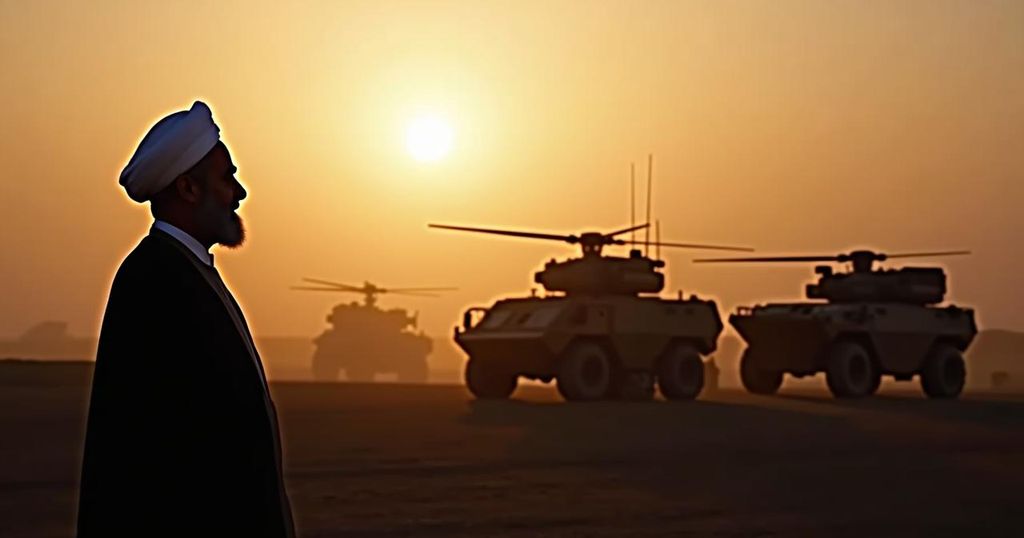Iran’s President Engages Diplomatically in Qatar Amid Military Exercises with Oman

Iranian President Masoud Pezeshkian embarks on a diplomatic visit to Qatar, participating in the ACD Summit amidst ongoing tensions with Israel. Parallelly, Iran conducts joint military exercises with Oman, marking a significant step in strengthening bilateral ties and regional influence. This reflects Iran’s strategy of fostering cooperation with nations opposing Israeli interests, while simultaneously enhancing its military readiness.
On Wednesday, Iranian President Masoud Pezeshkian is scheduled to travel to Qatar, following his recent participation in the UN General Assembly in New York. His itinerary highlights a series of international engagements, including a meeting with Russia’s Prime Minister earlier this week. This proactive approach reflects Iran’s efforts to strengthen diplomatic relations, particularly amidst ongoing hostilities against Israel orchestrated by Iranian proxies. During his visit to Doha, President Pezeshkian is expected to meet with Qatar’s Emir, Sheikh Tamim bin Hamad bin Khalifa Al Thani, and will attend the 19th Asian Cooperation Dialogue (ACD) Summit. His two-day visit is at the Emir’s invitation and includes participation in discussions with high-ranking officials from both nations, culminating in the signing of various cooperation agreements, as reported by state media. Qatar has become a host to leaders of Hamas and has adopted a critical stance against Israel in recent years, notably condemning its actions at the United Nations and opposing military operations in Lebanon against Hezbollah. While there have been calls for Doha to facilitate a ceasefire between Hamas and Israel, the likelihood of success in such negotiations appears diminished, placing Qatar’s role in a less favorable light than prior engagements. Pezeshkian’s pursuit of closer ties with Qatar mirrors a broader trend in the region where Iran aligns with Turkey, Russia, China, and other factions to counter Israeli influence. Moreover, President Pezeshkian’s attendance at the ACD—an initiative aimed at fostering cooperation among Asian nations—underscores Iran’s intent to fortify its position within international economic affiliations. This engagement aligns with Iran’s participation in groups such as BRICS and the Shanghai Cooperation Organization (SCO), reflecting a strategic pivot towards Russia and China. A significant development accompanying Pezeshkian’s trip is the commencement of joint military exercises between Iranian ground forces and those of Oman, dubbed Mountain Falcons 1 (Saqour al-Jabal 1). This marks a notable first for Iran, emphasizing collaboration in military training focused on enhancing operational readiness. Conducted in Oman’s Jebel Al-Khader province, these exercises involve ground forces from both nations, along with support from Oman’s Air Force and Royal Police. Iran’s relationship with Oman has evolved positively over recent years, particularly as Oman maintains a neutral stance on regional disputes. This neutrality was evident during the 2018 Gulf crisis, where Oman refrained from severing ties with Qatar. Given its geographical proximity to Yemen—where Iranian-aligned Houthis pose a security challenge—Oman’s partnership in military training with Iran raises important strategic questions yet may be interpreted as Iran seeking to leverage its influence more broadly across the Gulf region. Despite concerns regarding Iran’s military engagement, it is essential to differentiate between the Iranian ground forces involved in these exercises, who are often considered less ideologically driven than the Islamic Revolutionary Guard Corps. Thus, this collaboration may signify Iran’s desire to project stability and security in the region, albeit with the understanding that its concept of security often entails complex dynamics of influence and control.
The geopolitical landscape in the Middle East is shaped by intricate alliances and enmities, particularly involving Iran, Israel, and their respective allies. Iranian President Masoud Pezeshkian’s diplomatic endeavors, inclusive of meetings with international leaders and attendance at significant summits, illustrate Iran’s strategic efforts to consolidate its influence amidst growing regional tensions. Concurrently, Iran’s military collaboration with Oman represents an evolution in their bilateral ties, emphasizing a pragmatic approach in an often volatile environment. Qatar’s role as a mediator and host to groups such as Hamas complicates the dynamics further, as the nation has increasingly vocalized opposition to Israeli operations. This development comes at a time when Iran seeks to fortify relationships with other key players like Turkey, Russia, and China, while simultaneously addressing security efforts through military exercises with neighboring Oman.
In summary, President Masoud Pezeshkian’s upcoming visit to Qatar signifies Iran’s active engagement in international diplomacy amid ongoing conflicts involving its proxies against Israel. His participation in the ACD underscores the importance of regional cooperation, while joint military exercises with Oman may reflect a strategic recalibration in Iran’s influence. Through these actions, Iran seeks to strengthen alliances while navigating the complexities of regional stability and security, underlining a multifaceted approach to its geopolitical ambitions.
Original Source: www.jpost.com







